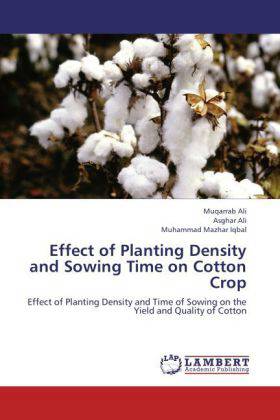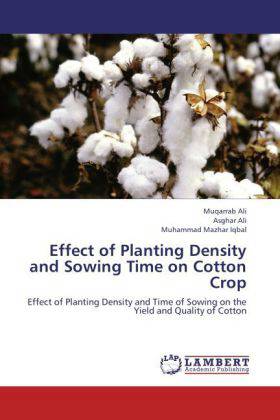
- Afhalen na 1 uur in een winkel met voorraad
- Gratis thuislevering in België vanaf € 30
- Ruim aanbod met 7 miljoen producten
- Afhalen na 1 uur in een winkel met voorraad
- Gratis thuislevering in België vanaf € 30
- Ruim aanbod met 7 miljoen producten
Zoeken
Effect of Planting Density and Sowing Time on Cotton Crop
Effect of Planting Density and Time of Sowing on the Yield and Quality of Cotton
Muqarrab Ali, Asghar Ali, Muhammad Mazhar Iqbal
Paperback | Engels
€ 59,95
+ 119 punten
Omschrijving
Cotton is an important fiber crop of Pakistan and is also the second most important oilseed crop in the world. The cotton plant possesses a narrow range of ecological adaptability and is very much influenced by the climatic conditions. Among many factors causing low yield, sowing time and plant spacing are more important. Therefore, the present study was designed to investigate the effect of different sowing times and plant distances on the growth, seed cotton yield and quality of cotton genotype BH-160 under the agro-ecological conditions of Rahim Yar Khan in irrigated environment. It may be concluded from this study that the boll number, boll weight and yield per plant decreased with closer spacing but seed cotton yield per hectare increased. The 15 cm plant to plant spacing produced more seed cotton yield due to more number to of plants per hectare, which compensated the other, yield components. Plants spacing however did not affect G.O.T%, seed index and fibre quality and plant height. Sowing date of 15th May gave maximum seed cotton yield and did not effect on monopodial branches.
Specificaties
Betrokkenen
- Auteur(s):
- Uitgeverij:
Inhoud
- Aantal bladzijden:
- 92
- Taal:
- Engels
Eigenschappen
- Productcode (EAN):
- 9783659198717
- Verschijningsdatum:
- 27/07/2012
- Uitvoering:
- Paperback
- Afmetingen:
- 152 mm x 229 mm
- Gewicht:
- 145 g

Alleen bij Standaard Boekhandel
+ 119 punten op je klantenkaart van Standaard Boekhandel
Beoordelingen
We publiceren alleen reviews die voldoen aan de voorwaarden voor reviews. Bekijk onze voorwaarden voor reviews.








